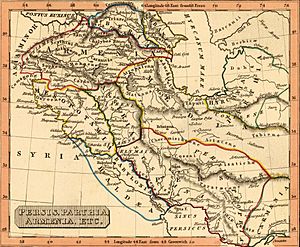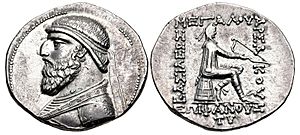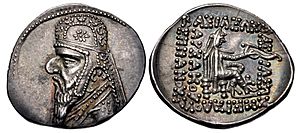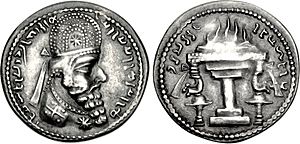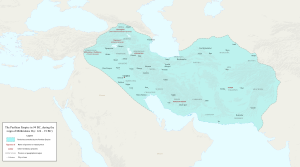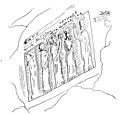Mithridates II of Parthia facts for kids
Quick facts for kids Mithridates II𐭌𐭄𐭓𐭃𐭕 |
|
|---|---|
| King of Kings | |

|
|
| King of the Parthian Empire | |
| Reign | 124 – 91 BC |
| Predecessor | Artabanus I |
| Successor | Gotarzes I |
| Died | 91 BC |
| Issue | Gotarzes I Mithridates III |
| Dynasty | Arsacid dynasty |
| Father | Artabanus I or Priapatius |
| Religion | Zoroastrianism |
Mithridates II (also called Mithradates II or Mihrdad II) was a powerful king of the Parthian Empire. He ruled from 124 to 91 BC. Many people in ancient times called him Mithridates the Great. He is known as one of the best rulers of his family, the Arsacid dynasty.
Mithridates II became king after his father, Artabanus I, died suddenly. The empire was facing problems from enemies in both the east and west. Mithridates II quickly made things stable again. He made friends with the ruler of Characene and took back control of the Kingdom of Elymais. He also stopped the Arabs from raiding Babylonia.
Mithridates II was the first Parthian king to expand his rule into the Caucasus region. Kingdoms like Armenia, Iberia, and possibly Caucasian Albania became part of his empire. In the east, he defeated nomadic tribes who had killed his father and his father's predecessor. He also took back Sakastan, giving it to a powerful family called the House of Suren.
By 114/113 BC, he captured Dura-Europos in Syria from the Seleucids. By 95 BC, other kingdoms in northern Mesopotamia, like Adiabene, Gordyene, and Osrhoene, accepted his rule. Under Mithridates II, the Parthian Empire grew very large. It stretched from Syria and the Caucasus all the way to Central Asia and India. It was also during his reign that the Parthian Empire first made contact with Rome and Han China.
Mithridates II really admired the old Achaemenid Empire. He wanted to show that his family, the Arsacid dynasty, was connected to that great empire. He was the first Parthian king to regularly use the title King of Kings. On his coins, he wore an Iranian tiara instead of the Greek-style diadem that earlier kings used. He also changed the design on the back of his coins to show a throne from the Achaemenid era.
Contents
What's in a Name?
The name "Mithridates" comes from Greek. It means "given by Mithra" in Iranian languages. Mithra was an ancient Iranian sun god. He was very important in Zoroastrianism, an old religion. Mithra was seen as a protector of khvarenah, which means kingly glory.
Mithra's importance grew during the time of the Seleucid Empire. He was linked to Greek gods like Apollo or Helios. He was also connected to the Babylonian god Nabu. Under the Parthians, Mithra became even more important. This might have been because Zoroastrians wanted to fight against other religions spreading during that time.
Who Was His Father?
It's not completely clear who Mithridates II's father was. Some ancient historians, like Justin, said he was the son of Artabanus I. However, an old clay tablet from 119 BC mentions Mithridates II talking about his "brother Artabanus." This makes things a bit confusing.
Some historians think that Mithridates II was actually the son of Priapatius. This idea is supported by another old writing found in Nisa. This writing mentions a Parthian king, likely Mithridates II's son Gotarzes I, as the "grandson of Friapatak." Friapatak is another name for Priapatius.
Other historians believe he was indeed the son of Artabanus I. They argue that if he was Priapatius's son, he would have been very old when he became king. The "brother Artabanus" mentioned in the clay tablet might have been a high-ranking officer, not a king, who died in battle.
Early Victories and New Lands
When Mithridates II became king, the Parthian Empire was in trouble. They had lost battles to nomadic tribes in the east. Mithridates II quickly made a deal with Hyspaosines, the ruler of Characene. Hyspaosines had previously fought the Parthians. He even gave Mithridates II a special wooden throne as a gift.
Mithridates II then turned his attention to Elymais. This region had been part of the Parthian Empire but had become independent. Mithridates II invaded Elymais, captured Susa, and defeated its king. Around the same time, Hyspaosines died. A Parthian general named Sindates became the new governor of Characene.
Mithridates II was the first Parthian king to expand into the Caucasus region. He saw that Armenia was in a very important location. Around 120 BC, he invaded Armenia. Its king, Artavasdes I, had to accept Parthian rule. Artavasdes I also had to give his son or nephew, Tigranes, to the Parthians as a hostage. Controlling Armenia remained very important for the Parthians. Other nearby kingdoms, like Iberia and possibly Caucasian Albania, also came under Parthian influence. Many Parthian coins found in these areas show their strong connection.
Old records from Babylonia show that Arabs were constantly raiding the region. This made Mithridates II very angry. In 119 BC, a Parthian army defeated the Arabs. This stopped their raids for a while. It's not clear if Mithridates II led this army himself.
Parthia also wanted to control Syria. The Parthians had first demanded Syria after defeating the Seleucid king Antiochus VII Sidetes in 129 BC. In 114/113 BC, Mithridates II captured the important city of Dura-Europos on the Euphrates river. At this time, the Seleucid kingdom was weak and had many internal conflicts.
Wars in the East
Mithridates II wanted to get revenge for his "parents or ancestors." This means he fought and defeated the Tocharians. These nomadic tribes had killed his father, Artabanus I, and his father's predecessor, Phraates II. Mithridates II also took back western Bactria from the Scythians.
Old coins and reports suggest that Mithridates II ruled over cities like Bactra and Termez. This means he had won back lands that an earlier king, Mithridates I, had conquered. Controlling the middle Amu Darya river was very important for the Parthians. It helped them stop nomads from Transoxiana from invading. Parthian coins were made in western Bactria and the middle Amu Darya until the time of Gotarzes II.
Nomadic invasions had also reached the eastern Parthian province of Drangiana. Strong groups of Saka people had settled there, which is why the area became known as Sakastan ("land of the Saka"). These nomads probably moved there because Mithridates II and Artabanus I were pushing them back in the north.
Sometime between 124 and 115 BC, Mithridates II sent an army to take back Sakastan. This army was led by a general from the House of Suren. After Sakastan was back in the Parthian Empire, Mithridates II gave the region to the Surenid general as his own land. Under Mithridates II, the Parthian Empire reached as far east as Arachosia.
Meeting the Romans
Tigranes, the Armenian prince, stayed as a hostage at the Parthian court until about 96/95 BC. Then, Mithridates II released him and made him king of Armenia. Tigranes gave Mithridates II a region called "seventy valleys" as a promise of loyalty. Tigranes' daughter, Ariazate, also married one of Mithridates II's sons. This marriage likely happened to ensure Tigranes would remain loyal. Tigranes stayed a Parthian ally for many years.
The next year, Mithridates II attacked and conquered Adiabene, Gordyene, and Osrhoene. These were city-states that moved the western border of the Parthian Empire to the Euphrates River. This is where the Parthians met the Romans for the first time.
In 96 BC, Mithridates II sent one of his officials, Orobazus, to meet with the Roman general Sulla. The Romans were becoming very powerful. The Parthians wanted to have a friendly relationship with them. They hoped to agree on mutual respect between the two empires. However, Sulla seemed to gain the upper hand in the talks. This made Orobazus and the Parthians look like they were begging. Orobazus was later executed for this.
Talking with China

In 121 BC, the Chinese, led by Emperor Wu of Han, defeated the Xiongnu in the east. They were expanding westward. In Ferghana, the Chinese met the Parthian Empire's area of influence. A Chinese group visited the Parthian court in 120 BC. The next year, the famous Silk Road was opened for trade. This road allowed valuable goods, like silk, to travel between China and the West.
One Chinese traveler described the strength and wealth of the Parthian Empire under Mithridates II.
End of His Reign
The last years of Mithridates II's rule are part of a time historians call the "Parthian Dark Age." This refers to about 30 years after Mithridates II's death. There isn't much clear information about what happened in the empire during this time. It's hard to know exactly who ruled when. Things become clearer again with the reign of Orodes II around 57 BC.
Old coins, carvings, and Babylonian records show that Gotarzes was the son and heir of Mithridates II. A damaged carving at Behistun suggests that Gotarzes was a very important official under his father. After Mithridates II died in 91 BC, Gotarzes was declared king in Babylon.
Imperial Style and Coins
Since the early 2nd century BC, the Arsacid kings started showing their connection to the ancient Achaemenid Empire. For example, they falsely claimed that the first Arsacid king, Arsaces I, was a descendant of the Achaemenid King of Kings, Artaxerxes II.
The Arsacids also started using Achaemenid titles. Mithridates I used the title "King of Kings." However, he didn't use it very often. It was Mithridates II, starting around 109/8 BC, who made this title a regular part of his rule. He used it on his coins and in writings. Mithridates II was more determined than earlier kings to show he was the true heir of the Achaemenid heritage.
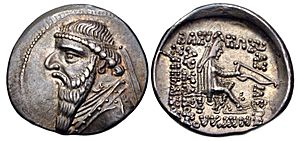
At the beginning of his reign, Mithridates II briefly used the Greek title Soter, meaning "Saviour." He used this on coins made in Ecbatana and Rhages. We don't know for sure why he used this title. Some historians think it was because he defeated the nomadic tribes. Others suggest it was linked to Mithra, who was seen as a savior in Zoroastrianism.
Early Arsacid kings wore a soft cap called a bashlyk on their coins. This cap was also worn by Achaemenid governors. From Mithridates I onwards, Parthian kings started using a Greek-style diadem. Mithridates II also used the diadem at first. But later, he began wearing a tall, jeweled tiara or kolah (tall hat).
This tiara came from the Median people. In the Achaemenid era, high-ranking Median officers wore a tall, domed hat. Media was an important region next to Parthia. The Parthians admired Median customs and learned about Achaemenid history through them. Many later Parthian kings also used this type of tiara. Even the founder of the Sasanian Empire, Ardashir I, used it. Like Artabanus I, Mithridates II is shown on his coins wearing a special Iranian rider's outfit called the Parthian trouser-suit.
The back of Mithridates II's coins also changed a lot during his rule. At first, they showed a seated archer wearing a bashlyk. This looked a lot like coins from an Achaemenid governor named Datames. The archer was first shown sitting on a diphros (a type of stool). Later, under Mithridates I, this changed to an omphalos (a stone representing the center of the world).
Coins made in Seleucia and Susa under Mithridates II kept this style. However, on coins from Ecbatana and Rhages, a tail-like piece of fabric was added behind the archer. Between 117 and 111 BC, the omphalos was replaced by a high-backed throne. This throne was originally used in the Achaemenid era. The long piece of fabric was also removed. During military gatherings, a horse or a gorytos (a type of quiver) was shown on the back of his coins.
His Legacy
Both ancient and modern historians think highly of Mithridates II. They see him as one of the greatest and most successful Parthian kings ever. He helped the empire grow and become very powerful.
Images for kids
See also
 In Spanish: Mitrídates II de Partia para niños
In Spanish: Mitrídates II de Partia para niños


